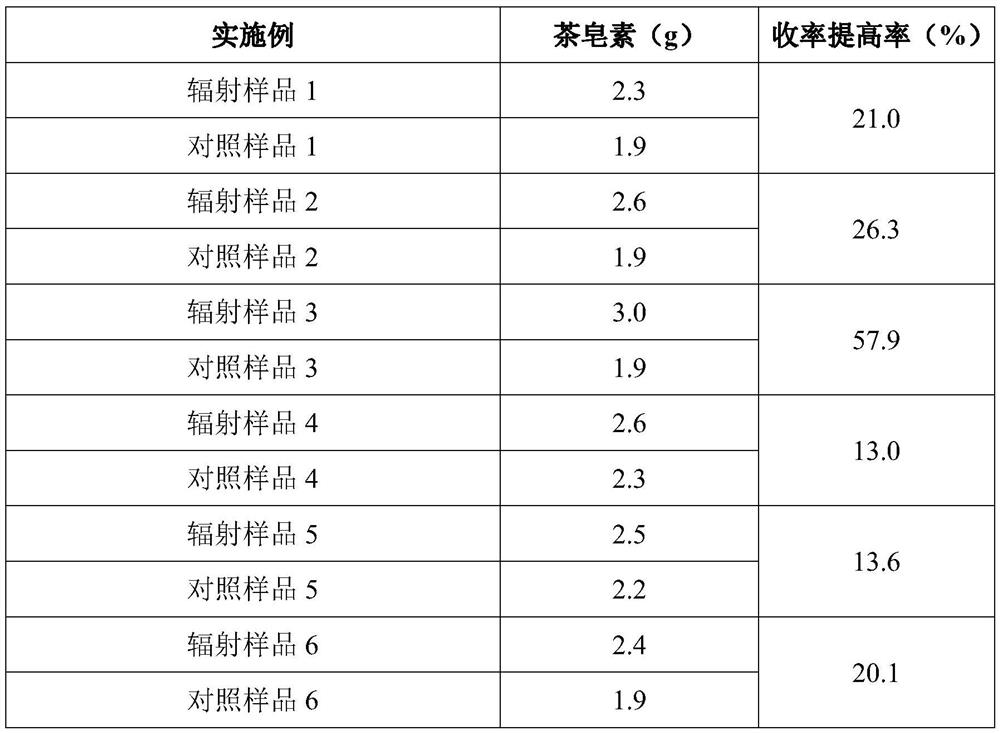A method for extracting tea saponin by irradiating tea dregs with 60co gamma rays
A technology of tea saponin and γ-rays, applied in chemical instruments and methods, steroids, organic chemistry, etc., can solve the problems of accelerated separation and extraction of tea saponin, unsatisfactory yield of tea saponin, poor production safety, etc. problems, and achieve the effects of obvious yield increase rate, high safety and simple operation
- Summary
- Abstract
- Description
- Claims
- Application Information
AI Technical Summary
Problems solved by technology
Method used
Image
Examples
Embodiment 1
[0018] a use 60 The method for extracting tea saponin from Co gamma ray radiation tea dregs comprises the steps:
[0019] (1) Soaking the tea meal: pulverize the dried (moisture content less than 5%) tea meal to 20-200 mesh, then add 10 g of water to 20 g of the tea meal, stir and disperse to soak the tea meal evenly;
[0020] (2) Radiation tea leaves: place the infiltrated tea leaves 60 In the Coγ-ray radiation field, the radiation dose is 1kGy, and the tea leaves are taken out after the radiation is completed;
[0021] (3) Solvent extraction: use water to extract the irradiated tea leaves, tea leaves (weight): water (volume) = 1:6, extraction temperature 60°C, extraction time 2h, repeat extraction three times , and the extract was collected by suction filtration, and after natural sedimentation, the supernatant liquid was taken and vacuum-dried to obtain yellow tea saponin in the form of solid powder.
[0022] Tea saponin can react with vanillin-concentrated sulfuric acid...
Embodiment 2
[0024] a use 60 The method for extracting tea saponin from Co gamma ray radiation tea dregs comprises the steps:
[0025] (1) Soaking the tea meal: pulverize the dried (moisture content less than 5%) tea meal to 20-200 mesh, then add 10 g of water to 20 g of the tea meal, stir and disperse to soak the tea meal evenly;
[0026] (2) Radiation tea leaves: place the infiltrated tea leaves 60 In the Coγ-ray radiation field, the radiation dose is 3kGy, and the tea leaves are taken out after the radiation is completed;
[0027] (3) Solvent extraction: use water to extract the irradiated tea leaves, tea leaves (weight): water (volume) = 1:6, extraction temperature 60°C, extraction time 2h, repeat extraction three times , and the extract was collected by suction filtration, and after natural sedimentation, the supernatant liquid was taken and vacuum-dried to obtain yellow tea saponin in the form of solid powder.
[0028] Tea saponin can react with vanillin-concentrated sulfuric acid...
Embodiment 3
[0030] a use 60 The method for extracting tea saponin from Co gamma ray radiation tea dregs comprises the steps:
[0031] (1) Soaking the tea meal: crush the dried (moisture content less than 5%) tea meal to 20-200 mesh, then add 6g of water to 20g of the tea meal, stir and disperse to soak the tea meal evenly;
[0032] (2) Radiation tea leaves: place the infiltrated tea leaves 60 In the Coγ-ray radiation field, the radiation dose is 5kGy, and the tea leaves are taken out after the radiation is completed;
[0033] (3) Solvent extraction: use water to extract the irradiated tea leaves, tea leaves (weight): water (volume) = 1:6, extraction temperature 60°C, extraction time 2h, repeat extraction three times , and the extract was collected by suction filtration, and after natural sedimentation, the supernatant liquid was taken and vacuum-dried to obtain yellow tea saponin in the form of solid powder.
[0034] Tea saponin can react with vanillin-concentrated sulfuric acid to for...
PUM
 Login to View More
Login to View More Abstract
Description
Claims
Application Information
 Login to View More
Login to View More - R&D
- Intellectual Property
- Life Sciences
- Materials
- Tech Scout
- Unparalleled Data Quality
- Higher Quality Content
- 60% Fewer Hallucinations
Browse by: Latest US Patents, China's latest patents, Technical Efficacy Thesaurus, Application Domain, Technology Topic, Popular Technical Reports.
© 2025 PatSnap. All rights reserved.Legal|Privacy policy|Modern Slavery Act Transparency Statement|Sitemap|About US| Contact US: help@patsnap.com

